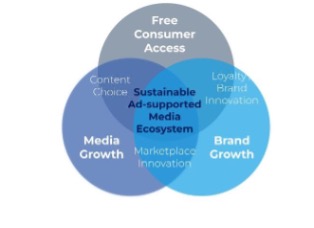Believe it or not, the advertising industry operates similarly to a finely balanced ecosystem in nature.
Take for instance, the Amazon Rainforest. At 2.5 million square miles, it is the largest self-sustaining ecosystem on earth. To help keep this natural ecosystem vibrant and healthy, three elements work in harmony to keep it in balance: air, water and sun. These interdependent elements ignite photosynthesis for animals to eat, plants to grow, and oxygen and carbon dioxide to continue their delicate exchange.
Just as nature has created a dynamic, interdependent template to sustain life, the advertising ecosystem also needs to be in balance to sustain its livelihood.
The balance of consumers, marketers and media companies
In a balanced and sustainable advertising ecosystem, the three necessary elements are consumers, marketers and media companies.

Each of the three core constituents gets something in exchange for providing something of value to the other. And they each need to work together to maintain order. First, let’s define what each constituency receives:
- Consumers get free or reduced cost access to great content
- Marketers get brand growth
- Media companies get money to continue funding great content
But a well-balanced ecosystem produces valuable ancillary byproducts too, as a result of co-dependent relationships. The exchange of money and inventory between marketers and media companies not only creates access to free or affordable inventory for consumers, but it inherently creates marketplace innovation.
When money is exchanged, expectations rise. And the result of the perpetual engagement between buyer and seller pushes the relationship to drive innovation. Some of the byproducts of this innovation are: data-driven linear, greater privacy compliance and the push for more accurate measurement.
The value exchange between marketers and consumers creates product innovation and customer loyalty. As marketers advertise their products and gain deeper relationships with their customers, their profits increase and they can keep a constant flow of product innovation to fulfill unmet customer needs. Or, in some cases, unknown customer needs. For example, a customer realizing that a traditional mop wasn’t good enough at capturing all the dust and dirt on a kitchen floor until they tried the Swiffer Wet Jet. Another example of a win-win situation.
And finally, the relationship between media companies and consumers has generated greater value for the two sides, as well. In exchange for watching its content, the media company can create more content based on selling more ads at higher prices. And with greater revenue, media companies can create new ways to view that content.
The unwritten value exchange between media companies and consumers has accelerated the growth of OTT and this has in turn provided consumers with more choice, more pricing options and more opportunities to watch advertisements from marketers.
The role of media disruptors
While this intricate dance between media companies, marketers and consumers is akin to walking a tight rope hanging high above the canopy in the Amazon, the natural tension yields great results. The intersection between the three groups is what helps sustain the media ecosystem. It is this delicate interplay that has taken us from newspaper, to radio, to TV, to digital and to OTT.
But there are interlopers who have invaded the media ecosystem and are challenging the equilibrium in new ways. The emergence of Netflix and Amazon in recent years means the media ecosystem’s balance is being challenged (Not surprising that one of the companies to enter the business arena as an ecosystem disruptor chose the biggest ecosystem on earth as their namesake, is it?).
The value exchange between marketers and consumers creates product innovation and customer loyalty.
When content is provided to consumers without ads, the marketer begins to get displaced. And while OTT is still relatively new, it is accelerating at a fast clip. If marketers remain excluded from this long-standing triad, unintended consequences can create a domino effect.
Marketers need to find new ways to engage and delight consumers, and this means more DTC brands and less money flowing through traditional media companies. As less money (potentially) flows through media companies, they have less to invest in free content, and consumers take the hit. It can become a vicious cycle.
But I am an optimist and always cheer for disruptors. Legacy models that don’t adapt die. And that is a long-learned lesson from the Amazon: adapt or die. In fact, the Galapagos Islands are the second largest natural ecosystem on earth, where Charles Darwin wrote his theory on the survival of the fittest, nicknamed “adapt or die.”
Making the pivot with technology
Advertising technology—embedded with privacy-compliant identity solutions that forecast consumer viewing and identify ways to maximize outcomes—can help the ecosystem adapt to the disruption. Just as air, water, and sun allow a natural ecosystem to adapt and thrive, the advertising industry must also adapt to thrive.
Innovation has been this industry’s energy source from the beginning, allowing us to pivot as the ecosystem evolves. And quite frankly, it’s time for a pivot. I believe we want to maintain a healthy advertising-supported ecosystem. It’s good business for consumers, marketers and media companies.
We must let the disruptors in and learn from them. The weak will get overrun, and the strong will make the system better. After all, Netflix just announced that it’s aiming to have advertising on its platform by the end of 2022. Everyone adapts. And that’s a good thing for all.














